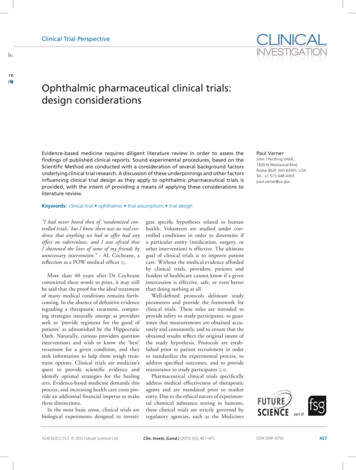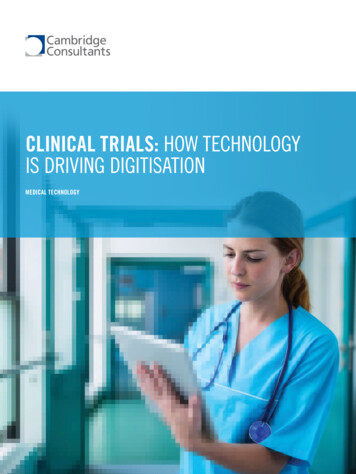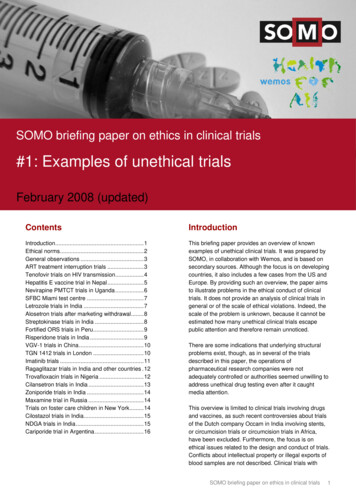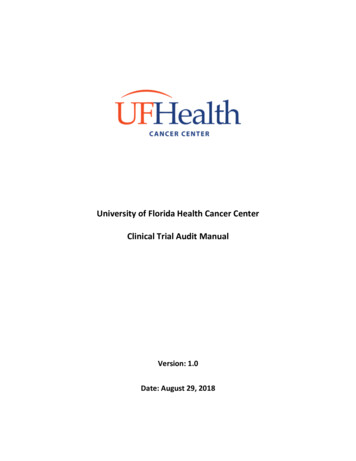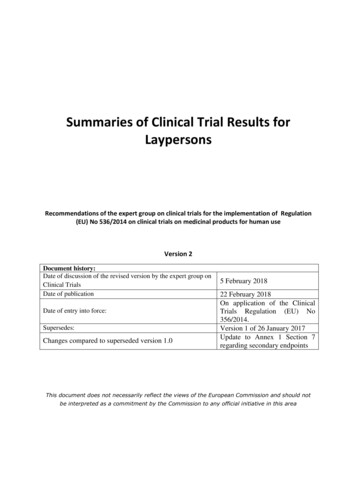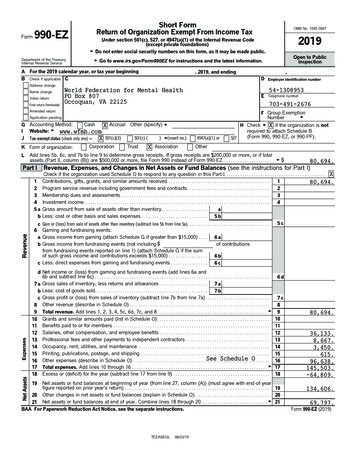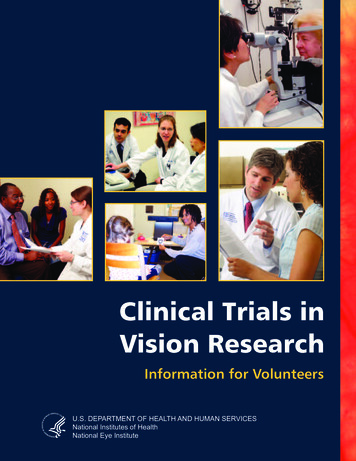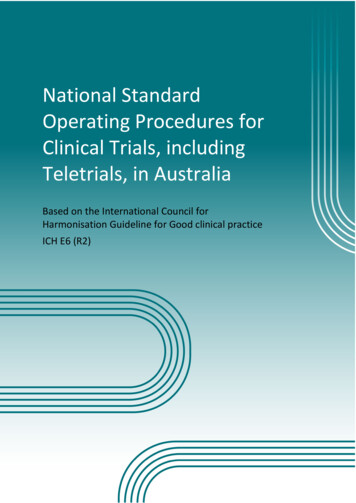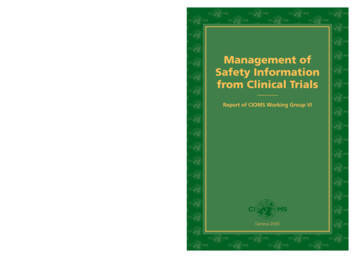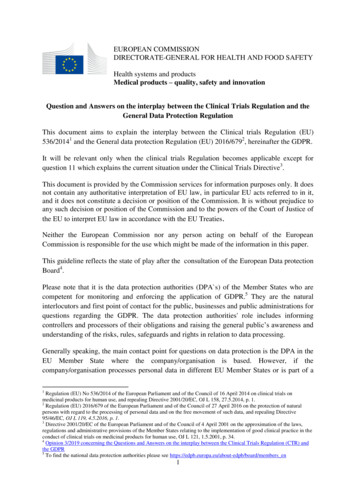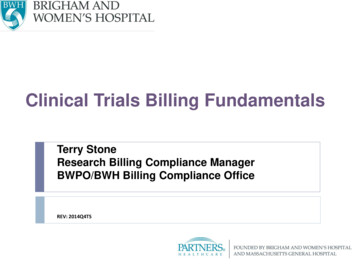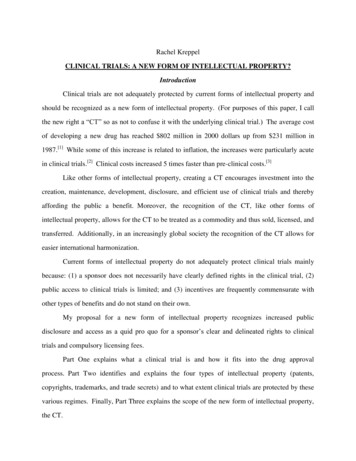
Transcription
Rachel KreppelCLINICAL TRIALS: A NEW FORM OF INTELLECTUAL PROPERTY?IntroductionClinical trials are not adequately protected by current forms of intellectual property andshould be recognized as a new form of intellectual property. (For purposes of this paper, I callthe new right a “CT” so as not to confuse it with the underlying clinical trial.) The average costof developing a new drug has reached 802 million in 2000 dollars up from 231 million in1987.[1] While some of this increase is related to inflation, the increases were particularly acutein clinical trials.[2] Clinical costs increased 5 times faster than pre-clinical costs.[3]Like other forms of intellectual property, creating a CT encourages investment into thecreation, maintenance, development, disclosure, and efficient use of clinical trials and therebyaffording the public a benefit. Moreover, the recognition of the CT, like other forms ofintellectual property, allows for the CT to be treated as a commodity and thus sold, licensed, andtransferred. Additionally, in an increasingly global society the recognition of the CT allows foreasier international harmonization.Current forms of intellectual property do not adequately protect clinical trials mainlybecause: (1) a sponsor does not necessarily have clearly defined rights in the clinical trial, (2)public access to clinical trials is limited; and (3) incentives are frequently commensurate withother types of benefits and do not stand on their own.My proposal for a new form of intellectual property recognizes increased publicdisclosure and access as a quid pro quo for a sponsor’s clear and delineated rights to clinicaltrials and compulsory licensing fees.Part One explains what a clinical trial is and how it fits into the drug approvalprocess. Part Two identifies and explains the four types of intellectual property (patents,copyrights, trademarks, and trade secrets) and to what extent clinical trials are protected by thesevarious regimes. Finally, Part Three explains the scope of the new form of intellectual property,the CT.
Part I: The Clinical Trial and FDA Approval ProcessA.What is a Clinical Trial?A clinical trial is any experiment in which a drug is administered or dispensed to, or usedinvolving, one or more human subjects.[4] Clinical trials may be classified by the desired goal,audience, or phase. Clinical trials defined by goals include: safety studies, efficacy studies,phamacokinetic studies, and pharmacology studies. Safety studies focus on evaluating whetherand to what extent a drug is suitable for human consumption. Safety studies may include testingfor dose tolerance, dose frequency, and duration of exposure to medicine.[5] Efficacy studies edrugisbeingproduced. Pharmacokinetic studies, including bioequivalence studies, are studies that focus onone or more of the basic pharmacological concepts: absorption, distribution, metabolism, andexcretion.[6] Bioequivalency studies are designed to show that as between different formulations,different dosage forms, products manufactured at different sites, or products made using differentmanufacturing methods that (1) the rate and extent of absorption are extremely similar; (2) theamount of each preparation reaching the bloodstream does not significantly differ; and (3) thepreparations are chemically equivalent.[7] To be bioequivalent for an ANDA approval (seeSection I.B. below), the applicant must show that either the rate and extent of absorption of thedrug does not show a significant difference from the rate and extent of absorption of the listeddrug when administered at the same molar dose of the therapeutic ingredient under multipledosesorthe extent of absorption of the drug does not show a significant difference from the extent ofabsorption of the listed drug when administered at the same molar dose of the therapeuticingredient under similar experimental conditions in either a single dose or multiple doses and thedifference from the listed drug in the rate of absorption of the drug is intentional, is reflected inits proposed labeling, is not essential to the attainment of effective body drug concentrations onchronic use, and is considered medically insignificant for the drug.[8] Pharmacology studiesfocus on new dosage formulations, new routes of administration, new dosing regimens, or other
characteristics of a drug’s pharmacologic profile.[9] Clinical trials that are classified by audiencetypically involve special populations, such as the elderly, children, or pregnant women.Generally, the pharmaceutical industry identifies four phases of clinical studies,appropriately called Phase I, Phase II, Phase III, and Phase IV. Phase I clinical studies aregenerally small, closely monitored studies done on healthy subjects to evaluate the safety of thedrug.[10] Phase I studies are designed to gain information about metabolism, side effects andpharmacokinetic and pharmacological effects.[11] Phase I studies also may provide keyinformation into the development of Phase II studies.[12] Phase II clinical studies are early studiesdone on a small number of patients further investigating the safety of the drug as well aspreliminary efficacy results.[13] Phase III clinical studies are expanded to involve a larger patientpopulation and further test the efficacy of the drug.[14] Phase IV clinical studies are generallypost-marketing studies that are not part of the NDA process prior to approval.B.Who is involved in a clinical trial?The various players in a clinical trial include: sponsors, subjects, investigators, staff ofthe investigators, contract research organizations (“CROs”), Institutional Review Boards(“IRBs”), and regulatory agencies, like the Food and Drug Administration (“FDA”). Sponsorsare those individuals, pharmaceutical companies, governmental agencies, academic institutions,private organizations or other organizations who take responsibility for and initiate a clinicaltrial.[15] Subjects include both healthy humans and patients with a disease who participate in aclinical trial, either as a recipient of the new drug or as a control.[16] Investigators are thoseindividuals who actually conduct and lead the administration of a clinical trial.[17] The staff ofthe investigator includes other physicians, nurses, and assistants that aide the investigator incarrying out the clinical trial. CROs are persons that assume some of the obligations of thesponsor as an independent contractor.[18] CROs provide an array of services ranging fromfinding investigator sites to developing protocols to analyzing data. Various types of CROsinclude independent companies that conduct clinical trials themselves, academic departments orgovernment agencies that conduct clinical trials, medical practices that solicit sponsors to
contract with them to conduct a clinical trial, and companies that place clinical trials primarily ina network of medical clinics that they have created.[19] IRBs are the boards that govern theinvestigating site that must approve and review the clinical trial protocol, including informedconsent forms. The U.S. regulatory agency governing the drug approval process is theFDA. Other countries have analogous agencies.An investigator is motivated to conduct clinical trials because he may be able to rewardin one of the following ways: by gaining prestige in his career, by obtaining medical benefits forhis patients (i.e. access to investigational new medicines or treatments), by obtaining newmedical or scientific equipment provided by the sponsor, by obtaining more staff, by obtainingfinancial rewards, and by being able to publish articles related to the clinical trial.[20]Sponsors selection of CROs and investigators usually takes into consideration the clientpopulation needed for the study, the reputation of the CRO or investigator (academic institutionsor those affiliated with an academic institution tend to have a better reputation), cost, rights topublish, and ownership of intellectual property related to or derived from the clinical trial. CROsand investigators that are academic institutions will rarely agree to a sponsor contract that doesnot give them the right to publish study results. Moreover, these academic institutions often willfight vigorously for intellectual property rights.C.How does a Clinical Trial fit into the Drug Approval Process?The Center for Drug Evaluation and Research (“CDER”), a division of the FDA, is incharge of approving drugs that are marketed for human use. Prior to a new drug being approvedfor the general public, an estimated eight-and-a-half years is needed to study and test thedrug.[21] The ultimate desired result achieved through interactions with the FDA is an approvalof either a New Drug Application (“NDA”)[22] or an Abbreviated New Drug Application(“ANDA”).[23] This approval allows a sponsor to market their drug to the public.The New Drug Development Process begins with identification of a compound orchemical entity for potential human use followed by pre-clinical research. Pre-clinical research
may include: synthesis studies, including manufacturing scale-up capabilities; purification; andanimal testing, usually performed in both rodents and non-rodents.Although some studies in the pre-clinical phase may be ongoing, the sponsor will want tobegin the clinical phase next. During the clinical phase clinical trials are developed,implemented and the resulting data is analyzed. Once the sponsor decides initiate a clinical trial,the sponsor (or a CRO designated by the sponsor) must: (1) develop a clinical trial protocolwhich usually requires assessing: the goals of the trial; the appropriate population(s) the trialsshould be done on; the appropriate forms for data collection; the appropriate mechanisms fordistribution and collection of drugs, data, etc.; and the methods of analyzing data.; (2) chooseand contract with the appropriate CROs and investigators; (3) obtain IRB approval from theinvestigator site; (4) oversee the administration of the clinical trial; (5) collect clinical trial data;(6) analyze clinical trial data; (7) report clinical trial results to the FDA; (8) and in somecircumstances, report clinical trial results in a publication, such as the American MedicalAssociation Journal or the New England Journal of Medicine.Prior to clinical studies being initiated, the FDA requires sponsor’s to submit data in theform of an investigational new drug application (“IND”) indicating that the drug is reasonablysafe for use in initial, small-scale clinical studies.[24] The IND technically allows for drugs to beshipped in interstate commerce for purposes of conducting clinical trials.[25] (Where a sponsordesires to manufacture and administer clinical trials within a single state, the sponsor need notfile an IND.) A sponsor may submit three main types of data that provide the necessary supportin their IND: (1) nonclinical data from in vitro laboratory or animal studies of the drug; (2)compiled data from previous clinical testing or marketing of the drug in the U.S. or anothercountry whose population is relevant to the U.S. population; or (3) new pre-clinicalstudies. Compared to the number of IND submissions, approximately seventy percent willcomplete Phase I studies, thirty-three percent will complete Phase II studies, and twenty-five tothirty percent will complete Phase III studies.[26]
Results of the clinical trials are used to support an NDA or ANDA. Usually, the FDAdoes not approve a drug for marketing prior to the completion of clinical trials. However, theFDA can grant NDA approval that is conditional upon the sponsor engaging in Phase IV studies.In analyzing whether to approve a drug, the FDA will review the following: (1) whetherthe drug is safe and effective for the proposed uses, and whether the benefits outweigh the risks;(2) whether the drug’s proposed labeling is appropriate; and (3) whether the methods used inmanufacturing the drug and the controls used to maintain the drug’s quality are adequate topreserve the drug’s identity, strength, quality, and purity.[27] Throughout the approval process,the sponsor and FDA frequently meet to discuss courses of action for the drug for whichapproval is sought. The sponsor is supplying the FDA with nonclinical as well as clinicaldata. In addition to the staff of CDER, CDER uses an advisory committee to obtain non-binding,outside advice and opinions to advise the agency on certain decisions.[28]D.NDAs and ANDAsAn NDA is made pursuant to the requirements of § 505 (b) of the Federal Food, Drug,and Cosmetic Act (“FFDCA”). The sponsor can submit an application under § 505 (b)(1) or §505 (b)(2). Under § 505 (b)(1), a sponsor must submit the following to support his NDA:(A) full reports of investigations which have been made to show whether or notsuch drug is safe for use and whether such drug is effective in use; (B) a full listof the articles used as components of such drug; (C) a full statement of thecomposition of such drug; (D) a full description of the methods used in, and thefacilities and controls used for, the manufacture, processing, and packing of suchdrug; (E) such samples of such drug and of the articles used as componentsthereof as the Secretary may require; and (F) specimens of the labeling proposedto be used for such drug. The applicant shall file with the application the patentnumber and the expiration date of any patent which claims the drug for which theapplicant submitted the application or which claims a method of using such drugand with respect to which a claim of patent infringement could reasonably beasserted if a person not licensed by the owner engaged in the manufacture, use, orsale of the drug.Under a § 505 (b)(2) application, the applicant submits all information required under §505(b)(1) except it need not supply those studies required under section A (full reports of
investigations which have been made to show whether or not such drug is safe for use andwhether such drug is effective in use). Thus, the applicant is allowed to submit an NDA wherecertain clinical trials relied on in the application are not conducted by or for the applicant and forwhich the applicant has not obtained a right of reference from the original sponsor of the clinicaltrial.An ANDA is made pursuant to the requirements of § 505 (j) of the FFDCA. An ANDAmust contain information to show that the conditions of use prescribed, recommended, orsuggested in the labeling have been previously approved (“listed drug”), information to showthat the route of administration, the dosage form and the strength of the new drug are the same asthose of a listed drug, information to show that the new drug is bioequivalent to the listed drug,information to show that the labeling is the same as the listed drug.In both 505(b)(2) and 505(j) applications the applicant must file a certification thatindicates how another’s patents relate to the drug that they investigated.[29] This certificationmust claim that: (i) the patent information has not been filed; (ii) that the patent is expired; (iii)that there is a patent and the date that the patent will expire; or (iv) that the patents are invalid orwill not be infringed by the manufacture, use, or sale of the new drug for which the application issubmitted (“Paragraph IV certification”).[30] Where a paragraph IV certification is made, theapplicant must provide notice to the patentee who then has 45 days to bring an infringementsuit.[31] If an infringement action is initiated, then a stay on the approval is granted for asuggested 30-months, which can be shortened or lengthened, to account for the actual time oflitigation.[32]In deciding whether to file and NDA or an ANDA, the applicant must first determinewhether the active ingredient has been previously approved. If not, the applicant must file anNDA pursuant to 505(b)(1). If the active ingredient has been tested previously, the applicantmay have the choice of filing an NDA or ANDA. In deciding which to file, the applicant will tryto balance the costs of engaging in clinical trials, the costs of the application, and the costs ofpotential litigation when a paragraph IV certification is made with the possible benefits of
approval, including any periods of exclusivity (see Section E below) that may be acquired andthe market for the drug. An ANDA applicant is benefited by having a lower cost of applying forapproval. This lower cost reflects the FDA’s ability to charge less because the review of theapplication is less labor-intensive as there is no need for the FDA to review previous safety andefficacy studies.
E.ExclusivityAn approved drug may be protected by patent exclusivity and non-patent exclusivity,including pediatric exclusivity and orphan drug exclusivity. Patent exclusivity exists for the lifeof the patent and allows only the patentee (and its licensees) to market the patented drug. Nonpatent exclusivity exists regardless of whether there is patent exclusivity. Non-patent exclusivitycan be granted for 7 years, 5 years, 3 years, 180 days, or 6 months. A 7-year period ofexclusivity is granted for rare diseases[33]. A 5 year period of exclusivity is granted where a newactive ingredient (including esters and salts) is approved.[34] During this 5 years no applicationmay be submitted that relies on the original’s trials except that those applications with aParagraph IV Certification may be filed at the beginning of the fourth year of exclusivity to seekapproval which will not be granted until the end of the 5-year period.[35] A 3-year period ofexclusivity is granted where a product is approved that is based on a previously approved activeingredient and contains new clinical trials (other than bioavailability studies) that are essential toapproval.[36] The 3-year period of exclusivity does not contain a provision similar to the 5-yearperiod that allows for early filing of an application if accompanied by a Paragraph IVcertification. A 180-day period of exclusivity is granted to the first ANDA applicant that files aParagraph IV certification.[37] The 180-day period begins at the earlier of the date of firstcommercial marketing or the court decision that the patent that was subject to certification wasinvalid or not infringed.[38] Pediatric exclusivity can not be granted independently and onlyextends 7-year, 5-year or 3-year exclusivity by six months for pediatric studies.Offering a sponsor the exclusive rights to market drugs is a powerful incentive.Non-patent exclusivity is important regardless of whether a patent is in place. If the patent is heldinvalid or unenforceable during the period of non-patent exclusivity, the patentee is still allowedto maintain the exclusivity on the remaining time left in the non-patent exclusivity. Moreover,non-patent exclusivity delays the time for which others can file an application relying on thosestudies. Finally, by only allowing pediatric exclusivity to attach to other forms of non-patent
exclusivity, there is no exclusivity incentive for a sponsor to engage in pediatric clinical trials ifthey have no other exclusivity related to the drug.Part II : Current Forms of Intellectual PropertyA.PatentsThe patent laws are enacted by Congress pursuant to its power under Article I, section 8,clause 8 of the Constitution. The patent statute, Chapter 35 of the U.S. Code, further definespatent rights.1.Subject MatterPatents are granted to whoever invents or discovers any new and useful process, andusefulimprovementthereof.[39] Additionally, the invention must be novel[40] and non-obvious.[41] The novelty andnon-obvious requirements prevent patents from being granted on trivial advances. The utilityrequirement prevents patents for being granted where there is no use for the invention. Utilityissues most frequently arise in the chemical arts where a compound is discovered but thepotential uses of the compound are unknown.2.RightsA patent gives the owner the right to exclude others from making, using, selling, offeringfor sale or importing the claimed invention in the United States.[42] The grant of a patent,however, does not give the inventor the right to practice the invention. In fact, the inventor mayhave to comply with other laws and regulations, such as those promulgated by the FDA. Apatentee can lose his rights to enforce his patent if it is held invalid or unenforceable. A patentwill be unenforceable where the patent was obtained through fraud. In some situations, a findingof unenforceability may be cured.3.Application and RegistrationUnlike other forms of intellectual property, a patent can only be recognized through aformal application process. In order to receive a patent, the applicant must apply to the U.S.Patent and Trademark Office which analyzes the patent to determine whether it meets the
rigorous patent standards. Throughout the application process, the patent application is keptconfidential.[43] mainsconfidential. Once the patent issues, the patent, as well as the history of the application becomespublic. In efforts to comply with international patent law, patents are now automaticallypublished 18-months after filing unless designated otherwise. If the applicant desires not to havethe application publish after 18-months, the applicant must file a non-publication request and isprecluded from filing internationally.[44] The Patent Office maintains an easily searchabledatabase of all patents that may be accessed via the Internet.[45]4.DurationA patent lasts for 20 years from the date of filing.[46] After a patent expires, the patent isdedicated to the public.5.Ownership and TransferabilityAn inventor(s) that creates a patentable invention is the first owner of the patent. Patentsare freely assignable and may be assigned in whole or in part.[47] Frequently, patents areassigned from an employee to his employer through his employment contract. Additionallypatents may be licensed only with the permission of the owner.[48]6.Underlying PolicyObtaining this right to exclude for 20 years, or as some would define it a limitedmonopoly, is a strong and powerful right, but it is not without its costs. In return for this right,the inventor must disclose his invention, including the manner and process of making and usingit, so that one of ordinary skill in the art would be able to make and use the invention. [49] Inaddition, the inventor must set forth the best mode of carrying out the invention.[50]In determining the duration and scope of patent rights, Congress has determined that thebenefits of the scope and duration of the patent rights afforded to the owner provide enoughincentive to encourage disclosure of the information to the public and are commensurate with thedetriment to the public of not being able to practice the invention without a license for theduration of the patent.
7.How are clinical trials currently protected by patents?Assuming that all of the statutory requirements are met, patent law could protect newchemical entities and new drugs, new formulations of drugs, methods of manufacturingchemicals or drugs, and methods of using the chemicals or drugs. Thus, patents may be obtainedfrom clinical trial results that indicate a new use or method of using a drug. However, theunderlying studies are not generally protected by patent law. In fact, the patent law makes anexception that allows others to engage in clinical research without violating a patent.[51] In aneffort to balance this exception, Congress provided that the filing of a Paragraph IV certificationfor either ANDAs or NDAs is an act of infringement.[52]The patent laws also recognize that the time to get a drug approved by the FDA can beconsiderable and can decrease the value of the patent because by the time the drug is approvedthere is considerably less time to enforce the patent. To further encourage disclosure ofinventions, a patent term extension may be granted for those compositions or processes that aresubject to regulatory review by the FDA pursuant to the FFDCA.[53] The term of the patent maybe extended if it has been subject to a regulatory review period before commercial marketing oruse.[54] The patent is thereby extended by the amount of time equal to the regulatory reviewperiod that occurs after the patent issues, less periods of time where the applicant was not actingdiligently in the review process.[55] However, the grant of such extension shall not exceed 14years.[56]B.Trademarks[57]Trademark law, unlike patent and copyright law, has both federal and state laws thatdictate its scope, rights, and enforcement. The Federal trademark law, the LanhamAct,[58] describes the scope of federal protection afforded to trademarks. Congress enacted theLanham Act under its power to regulate interstate commerce. States also have their own statutesand/or common law doctrine that govern trademarks.1.Subject Matter
A trademark is used to identify goods or services with a source. A trademark may takethe form of a word, logo, design, color, scent, or sound. The trademark must be inherentlydistinctive or become distinctive due to acquired meaning. Trademarks come into existencewhen they are used in commerce to identify the source or quality of goods or services.[59]2.RightsA trademark gives the owner the right to exclude others from using the mark or acolorable variation thereof in connection with the sale, offering for sale, distribution oradvertising of goods or services that is likely to cause confusion, mistake or deception [60] ordilutes the trademark.[61] A trademark owner can lose its rights if the mark becomes generic, ifthe rights have been abandoned, or if the trademark was obtained through fraud.[62]3.Application and RegistrationAlthough a federal trademark registration is not necessary to recognize trademark rights,registration does afford the owner benefits, including the right to sue under the LanhamAct.[63] Federal trademarks may only be registered if there is use in interstatecommerce.[64] Federal registration will not be permitted in a variety of circumstances, includingif the trademark so resembles another registered trademark that it is likely to cause ly descriptiveoraswholeisfunctional.[65] Registered trademarks are published in the Official Gazette and are easilysearchable in the trademark database that now may be accessed via the Internet.4.DurationTrademarks can exist for an infinite length of time. A trademark ceases to exist if themark becomes generic, if the rights have been abandoned, or if the trademark was obtainedthrough fraud.[66]5.Ownership and TransferabilityTrademark rights are owned by the entity that creates the association between the markand the good or service. Trademark rights are assignable[67] and licensable. Licensing can belimited in scope to either a particular market (either geographic, type of store (i.e. supermarkets,
pharmacies, etc.)), duration, or type of good or service. When licensing a trademark, the ownermust take great care to insure that quality control standards and control remain with theowner. Failure to take these precautions may result in loss of trademark rights.6.Underlying PolicyTrademarks are generally justified as providing a benefit to the public and providingincentive to owner to maintain consistent quality in his product. The public is benefited bybeing able to quickly and efficiently identify and distinguish products. Additionally, consumersbenefit by receiving goods or services that have a consistent quality.7.How are clinical trials currently protected by trademarks?There is very little in the clinical trial process that would be protected by trademarklaw. The only possible areas where trademark protection would be available would be for thetrademarked name of the drug and in some rare instances, services that would be provided with adrug that was offered (i.e. if for example a mark were attached to a way of administeringchemotherapy that was in a specific simulated environment). However, the brand name of adrug is usually not used in the actual clinical trial. In fact the technical name of the drug isfrequently not revealed to the subject[68] or not revealed to either the subject or theinvestigator.[69] Once the drug is on the market, however, the trademark protection of a drug isvaluable.C.CopyrightsThe copyright laws are enacted by Congress pursuant to its power under Article I, section8, clause 8 of the Constitution. In turn, Congress has enacted the Copyright Statute.[70]1.Subject MatterCopyrights protect the original works of authorship that are fixed in any tangible mediumof expression regardless of whether it has been published.[71] A copyright protects expression,and not the underlying facts or ideas, procedures, processes, systems, methods of operation,concepts, principles, or discoveries.[72]2.Rights
Copyright protection consists of a bundle of rights including the right to distribute copiesand the right to create derivative works.[73] Copyrights protect the owners from unauthorized useof the copyrighted work. Copyrights do not protect uses which are considered fairuses.[74] Copyrights do not protect the owner if another individual develops the exact same workor a substantially similar work provided that the new work was developed independently.
3.Application and RegistrationSimilar to trademarks, copyrights need not be registered. However, a copyright ownermay not receive statutory damages and attorney’s fees without this registration. [75] To register acopyright, the applicant must deposit a sample with the Copyright Office.[76] The CopyrightOffice checks to make sure that the application contains copyrightable subject matter prior to
clinical trial, either as a recipient of the new drug or as a control.[16] Investigators are those individuals who actually conduct and lead the administration of a clinical trial.[17] The staff of the investigator includes other physicians, nurses, and assistants that aide the investigator in carrying out the clinical trial.

